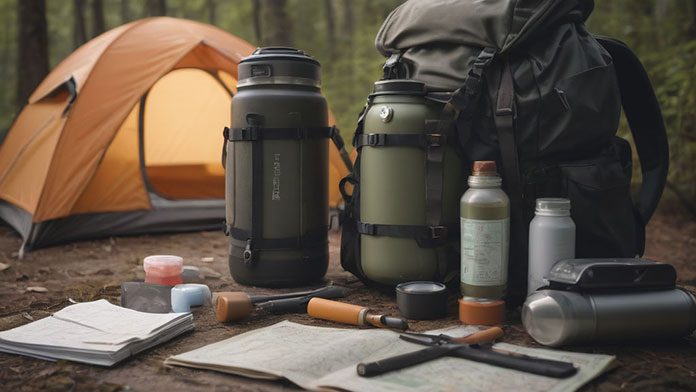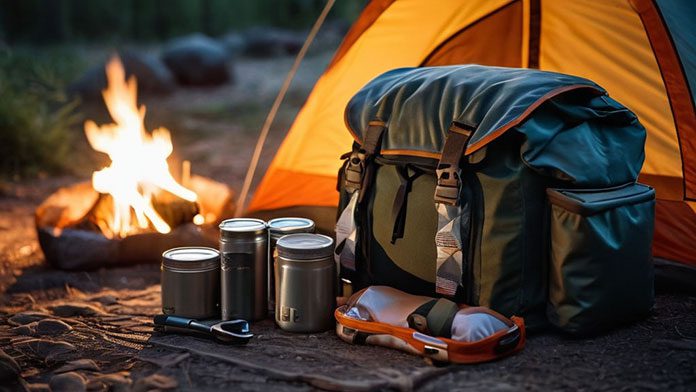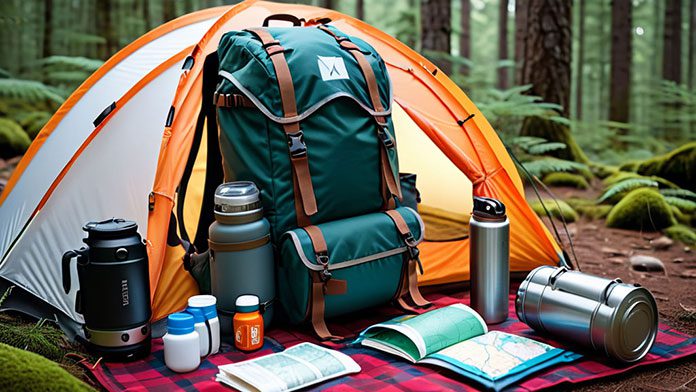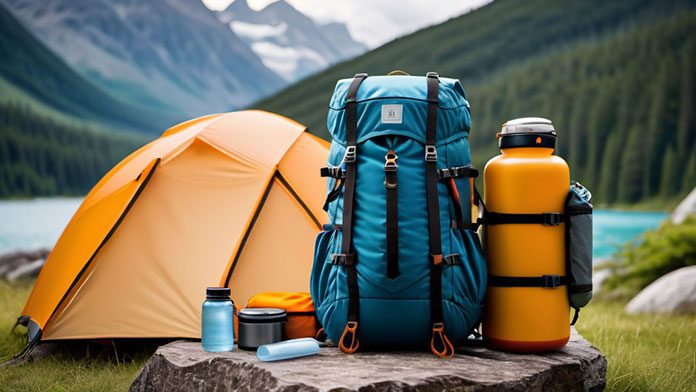You’re heading out on a camping trip, and you’re excited to explore the great outdoors. But before you venture into the wilderness, you need to make sure you have everything you need. That’s where this article comes in.
We’ve put together a list of seven essential items that you must pack for your camping trip. From a sturdy tent to a first aid kit, we’ll guide you through the must-haves to ensure your camping experience is safe and enjoyable.
So grab your backpack and let’s get started!
Table of Contents
![Packing for Camping [ What You NEED! ]](https://i.ytimg.com/vi/_qdMCO7CyYY/hqdefault.jpg)
Related Video: "Packing for Camping [ What You NEED! ]" by WayPoint Survival
Main Points
– When choosing a tent, consider factors such as size, capacity, durability, waterproof material, setup ease, weight, and size.
– Select a sleeping bag based on temperature rating, insulation type, size, and weight.
– For cooking and eating utensils, pack a compact and lightweight camping stove, pots and pans made of stainless steel or aluminum, cooking utensils (spatula, tongs, spoon, knife), and reusable plates, bowls, and utensils (plastic or lightweight stainless steel).
– Don’t forget to include a first aid kit with adhesive bandages, gauze pads, adhesive tape, antiseptic wipes or solution, sterile gloves, scissors, tweezers, splints, thermometer, pain relievers, allergy medication, and personal medications.
Tent

When packing for a camping trip, make sure to bring a tent that’s suitable for the number of people you’ll be camping with. Your tent is one of the most important items to consider when planning your camping adventure. It provides shelter and protection from the elements, ensuring a comfortable and safe experience in the great outdoors.
When choosing a tent, consider the size and capacity. A good rule of thumb is to select a tent that’s designed to accommodate one or two more people than you actually have. This allows for extra space for gear and ensures everyone has enough room to sleep comfortably. Look for a tent with a durable and waterproof material to keep you dry during unexpected rain showers.
Additionally, consider the tent’s setup and ease of use. Look for a tent that’s quick and easy to assemble, especially if you’re new to camping. Features like color-coded poles and clear instructions can make the setup process a breeze. It’s also worth considering the weight and size of the tent, as you’ll need to transport it to your campsite.
Sleeping Bag

Don’t forget to pack a comfortable sleeping bag for your camping trip. A good sleeping bag is essential for a restful night’s sleep in the great outdoors. When choosing a sleeping bag, consider factors such as temperature rating, insulation type, size, and weight.
To help you make an informed decision, here is a comparison table of different sleeping bags:
| Sleeping Bag | Temperature Rating | Insulation Type | Size | Weight |
|---|---|---|---|---|
| Bag A | 0°F | Down | Regular | 3 lbs |
| Bag B | 20°F | Synthetic | Long | 4 lbs |
| Bag C | 40°F | Down/Synthetic | Regular | 2.5 lbs |
| Bag D | 50°F | Synthetic | Regular | 2 lbs |
| Bag E | 60°F | Down | Regular | 1.5 lbs |
Bag A is suitable for colder temperatures, while Bag E is better for warmer climates. Bag B offers a balance between warmth and weight, making it a versatile option. Bag C combines the benefits of both down and synthetic insulation, providing warmth even in damp conditions. Bag D is lightweight and perfect for summer camping trips.
Cooking Utensils

Now let’s talk about the essential cooking utensils you should pack for your camping trip. When it comes to cooking in the great outdoors, having the right tools can make all the difference.
First and foremost, you’ll need a sturdy and reliable camping stove. Look for one that’s compact, lightweight, and easy to use. A good camping stove will allow you to cook your meals quickly and efficiently.
Next, don’t forget to pack a set of pots and pans. Opt for ones that are made of lightweight and durable materials such as stainless steel or aluminum. Make sure to choose a variety of sizes to accommodate different types of meals.
A set of cooking utensils is also a must-have. Include items such as a spatula, tongs, a spoon, and a knife. Look for utensils that are made of heat-resistant materials and have long handles to keep your hands safe from the heat.
Additionally, you’ll need some plates, bowls, and utensils for eating. Consider using reusable options made of plastic or lightweight stainless steel to reduce waste.
Lastly, don’t forget to pack a can opener and a bottle opener. These small but essential tools will come in handy when opening cans and bottles.
First Aid Kit

To ensure your safety and well-being during your camping trip, it’s essential to include a well-stocked first aid kit in your packing list. Accidents can happen, and being prepared with the necessary medical supplies can make a significant difference in handling any injuries or illnesses that may occur while you’re in the great outdoors.
When assembling your first aid kit, it’s important to include a variety of items to address different types of injuries. Start with the basics, such as adhesive bandages in various sizes, gauze pads, and adhesive tape for dressing wounds. You’ll also want to include antiseptic wipes or solution to clean wounds and prevent infection.
For more serious injuries, it’s crucial to have items like sterile gloves, scissors, tweezers, and splints. These tools can assist in managing fractures, removing splinters, or safely cutting clothing away from an injury. Additionally, having a thermometer, pain relievers, and allergy medication can be helpful for treating common ailments that may arise during your trip.
Lastly, don’t forget to pack any personal medications, such as prescription drugs or allergy medication, that you may need while camping. It’s crucial to have enough of these medications to last the duration of your trip.
Clothing and Footwear
When it comes to clothing and footwear for your camping trip, there are two important points to consider: layering for changing weather and wearing comfortable and durable footwear.
Layering is essential because temperatures can fluctuate throughout the day, and being able to add or remove layers will keep you comfortable. Choose clothing made of moisture-wicking materials to keep you dry and warm.
As for footwear, opt for shoes or boots that provide good support and traction, as you’ll likely be walking on uneven terrain.
Layering for Changing Weather
Pack enough clothing and footwear to layer for changing weather conditions, so you can stay comfortable throughout your camping trip.
The key to staying comfortable in changing weather is to dress in layers. Start with a moisture-wicking base layer, such as thermal underwear or a lightweight long-sleeve shirt, to keep your body dry and regulate temperature.
Next, add an insulating mid-layer, like a fleece or down jacket, to provide warmth. Finally, top it off with a waterproof and windproof outer layer, such as a rain jacket or shell. This will protect you from rain, wind, and snow.
Don’t forget to pack extra socks and sturdy, waterproof footwear.
Layering your clothing and footwear will allow you to easily adjust your outfit depending on the weather, ensuring that you stay comfortable and prepared for any conditions.
Comfortable and Durable Footwear
Ensure your comfort and safety on your camping trip by packing comfortable and durable footwear. When it comes to camping, footwear is one of the most important items to consider. You’ll be spending a lot of time on your feet, exploring and hiking through various terrains. Therefore, it’s crucial to choose footwear that provides the necessary support and protection.
Opt for hiking boots or sturdy trail shoes that have good traction and ankle support. Look for waterproof or water-resistant options to keep your feet dry in case of rain or wet conditions. Additionally, make sure your footwear is breathable to prevent sweat and odor buildup.
Don’t forget to break in your shoes before your trip to avoid blisters and discomfort. Investing in high-quality, comfortable footwear will ensure a pleasant and pain-free camping experience.
Lighting Equipment
Be sure to include a headlamp or flashlight in your camping gear. When you’re camping, it’s essential to have reliable lighting equipment to help you navigate through the dark and illuminate your campsite. A headlamp or flashlight will provide you with hands-free lighting, allowing you to perform tasks such as cooking, setting up your tent, or even going to the bathroom in the middle of the night.
To help you choose the right lighting equipment for your camping trip, refer to the table below:
| Equipment | Pros | Cons |
| Headlamp | Hands-free lighting | Limited range of illumination |
| Flashlight | Strong and focused beam | Requires holding in hand |
| Lantern | Provides ambient lighting | Bulky and takes up space |
Headlamps are a popular choice for campers due to their convenience. They wrap around your head, leaving your hands free to perform other tasks. However, their range of illumination may be limited compared to flashlights. On the other hand, flashlights provide a strong and focused beam, allowing you to see objects at a distance. But, they require you to hold them in your hand, which can be cumbersome for extended periods.
Lastly, lanterns are great for providing ambient lighting, creating a cozy atmosphere at your campsite. However, they can be bulky and take up space in your camping gear. Choose the lighting equipment that suits your needs and preferences for a well-illuminated camping experience.
Miscellaneous Essentials
Don’t forget to include some miscellaneous essentials in your camping gear to enhance your outdoor experience even further. While it’s easy to focus on the big-ticket items like tents, sleeping bags, and cooking equipment, there are a few smaller items that can make a big difference.
One such item is a portable camping chair. After a long day of hiking or exploring, having a comfortable place to sit and relax can be a game-changer. Look for a chair that’s lightweight and easily collapsible, so it doesn’t take up too much space in your pack.
Another essential item to consider is a camping hammock. Not only are hammocks incredibly relaxing, but they also provide an alternative sleeping option. Setting up a hammock between two trees allows you to sleep off the ground, away from any rocks or uneven terrain. Plus, it gives you the chance to stargaze or simply enjoy the peacefulness of nature.
Lastly, don’t forget to pack a few extra carabiners. These versatile clips can be used for a variety of purposes, such as attaching gear to your backpack, securing a tarp or rainfly, or even creating a makeshift clothesline to dry wet clothes. They’re lightweight, durable, and incredibly handy in a pinch.
Frequently Asked Questions
Are Camping Tents Waterproof and Suitable for All Weather Conditions?
Yes, camping tents are designed to be waterproof and withstand different weather conditions. They are made with special materials and features like rainflys and sealed seams to keep you dry and comfortable during your camping adventures.
How Do I Choose the Right Size Sleeping Bag for My Camping Trip?
When choosing a sleeping bag for your camping trip, consider your height and the weather conditions. A bag that is too small will be uncomfortable, while one that is too big may not keep you warm.
What Cooking Utensils Should I Bring for a Camping Trip?
When camping, you should bring a set of basic cooking utensils. These include a pot, pan, spatula, and tongs. These items will help you prepare meals over a campfire or portable stove.


